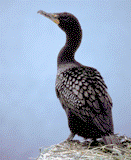United States Department of Agriculture, National Wildlife Research Center: Symposia

Symposium on Double-Crested Cormorants: Population Status and Management Issues in the Midwest
Date of this Version
December 1997
Abstract
Double-crested cormorants (Phalacrocorax auritus) are receiving increasing attention in North America because of depredations at aquaculture facilities and alleged impacts on sport and commercial fisheries. We obtained recent (most since 1994) estimates for the number of nesting double-crested cormorants in the United States and Canada from published references and by conducting telephone interviews with State and Provincial biologists. Using published data, we also determined annual rates of change in the number of cormorants since about 1990. The estimated minimum number of nesting pairs (colonies) of double-crested cormorants was 372,000 (852). Most cormorants nested in the Interior region (68 percent). Overall, double-crested cormorants increased about 2.6 percent annually during the early 1990’s. The greatest decline (&#;7.9-percent annual change) was in the West Coast–Alaska region. The greatest increase (6.0-percent annual change) was for the Interior region. The increase there was primarily a consequence of a 22-percent annual increase in Ontario and U.S. States bordering the Great Lakes. These baseline population data are essential for monitoring trends in nesting populations and for developing informed management decisions. However, the completeness, quality, and timing of surveys varied substantially among jurisdictions. Population estimates and rates of change should, therefore, be used with caution. Methods and timing of future surveys should be coordinated among political jurisdictions (at least within regions) to improve accuracy of estimates and allow more meaningful comparisons of population status.

